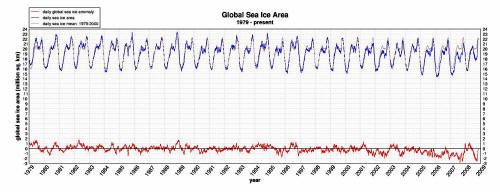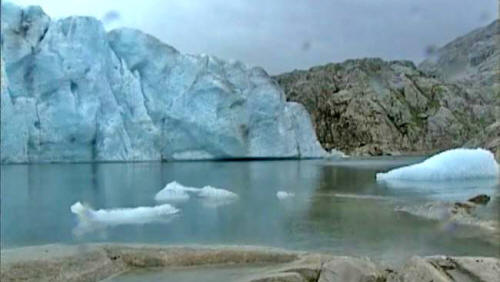|

by
thefifthseal
01 December 2008
from
YouTube Website
Rapid Rebound Brings Ice Back to
Levels from the 1980s
from
DailyTech Website
An abnormally cool Arctic is seeing dramatic changes to ice levels.
In sharp contrast to the rapid melting seen last year, the amount of
global sea ice has rebounded sharply and is now growing rapidly. The
total amount of ice, which set a record low value last year, grew in
October at the fastest pace since record-keeping began in 1979.

The actual amount of ice area varies seasonally from about 16 to 23
million square kilometers. However, the mean anomaly - defined as
the difference between the current area and the seasonally-adjusted
average - changes much slower, and generally varies by only 2-3
million square kilometers.
That anomaly had been negative, indicating ice loss, for most of the
current decade and reached a historic low in 2007. The current value
is again zero, indicating an amount of ice exactly equal to the
global average from 1979-2000.
Bill Chapman, a researcher with the Arctic Climate Center at the
University of Illinois, says the rapid increase is "no big deal". He
says that, while the Arctic has certainly been colder in recent
months, the long-term decrease is still ongoing. Chapman, who
predicts that sea ice will soon stop growing, sees nothing in the
recent data to contradict predictions of global warming.
Others aren't quite so sure. Dr. Patrick Michaels, Professor of
Environmental Science at the University of Virginia, says he sees
some "very odd" things occurring in recent years.
Michaels, who is
also a Senior Fellow with the Cato Institute, tells DailyTech that,
while the behavior of the Arctic seems to agree with climate models
predictions, the Southern Hemisphere can't be explained by current
theory.
"The models predict a warming ocean around Antarctica, so
why would we see more sea ice?"
Michaels adds that large areas of
the Southern Pacific are showing cooling trends, an occurrence not
anticipated by any current climate model.
On average, ice covers roughly 7% of the ocean surface of the
planet. Sea ice is floating and therefore doesn't affect sea level
like the ice anchored on bedrock in Antarctica or Greenland.
However, research has indicated that the Antarctic continent --
which is on a long-term cooling trend -- has also been gaining ice
in recent years.
The primary instrument for measuring sea ice today is the AMSR-E
microwave radiometer, an instrument package aboard NASA's AQUA
satellite. AQUA was launched in 2002, as part of NASA's Earth
Observing System (EOS).
Sea Ice
Growing at Fastest Pace on Record
Glaciers in Norway Growing Again
So Much For Global Warming...
by
thefifthseal
06 December 2008
from
YouTube Website
Scandinavian nation
reverses trend
mirrors results in Alaska, elsewhere
from
DailyTech Website
After years of decline, glaciers in Norway are again growing,
reports the Norwegian Water Resources and Energy Directorate (NVE).

The actual magnitude of the growth, which appears to have begun over
the last two years, has not yet been quantified, says NVE Senior
Engineer Hallgeir Elveh°y.
-
The flow rate of many glaciers
has also declined
-
Glacier flow ultimately acts to
reduce accumulation, as the ice moves to lower, warmer
elevations
-
The original trend had been
fairly rapid decline since the year 2000
-
The developments were originally reported by the Norwegian
Broadcasting Corporation (NRK)
DailyTech has previously reported on the growth in Alaskan glaciers,
reversing a 250-year trend of loss. Some glaciers in Canada,
California, and New Zealand are also growing, as the result of both
colder temperatures and increased snowfall.
Ed Josberger, a glaciologist with the U.S. Geological Survey, says
the growth is "a bit of an anomaly", but not to be unexpected.
Despite the recent growth, most glaciers in the nation are still
smaller than they were in 1982. However, Elveh°y says that the
glaciers were even smaller during the 'Medieval Warm Period' of the
Viking Era, prior to around the year 1350.
Not all Norwegian glaciers appear to be affected, most notably those
in the Jotenheimen region of Southern Norway.
Glaciers in Norway Growing Again
|


